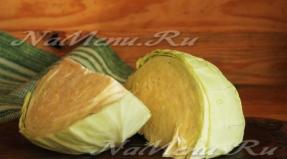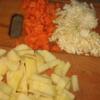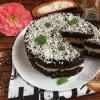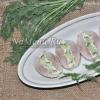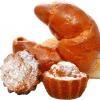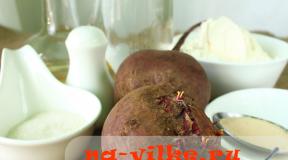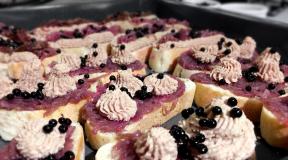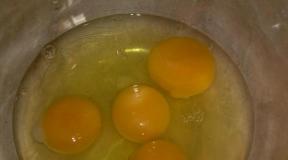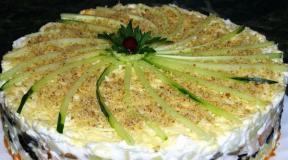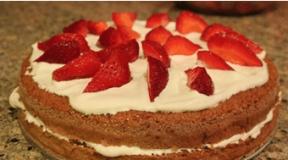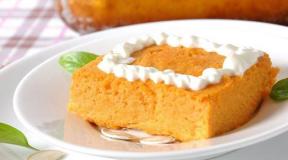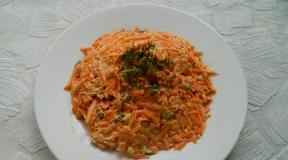Little oatmeal. Review: baby porridge oatmeal with fruit
Milk dry instant oatmeal porridge
Baby, for feeding children from 5 months.
Kashi Malyutka is so delicious thanks to a special gentle technology for processing cereals. They retain their natural taste and smell, although they require more stirring.
Each serving is a source of carbohydrates, proteins, vitamins and minerals necessary for development. Porridges are easily digestible and have a high nutritional value. Kashi Malyutka - very tasty, satisfying and healthy!
“1 step. A caring start.
“Experts from the Nutricia company created Malyutka porridges specifically for the start of complementary foods. They have a delicate texture and are easy to digest, meeting the basic needs of children at this age.
Milk dry instant oatmeal porridge Malyutka, for feeding children from 5 months,
in accordance with the requirements of the legislation of Russia and the Republic of Kazakhstan.
For optimal growth, development and health of the baby, the World Health Organization recommends exclusive breastfeeding for the first 6 months of life and subsequent introduction of complementary foods while continuing breastfeeding. Nutricia fully supports these recommendations.
Consult with a specialist before using the product.
- Very tasty porridge
- For baby food.
- It is recommended to cook porridge immediately before use.
- Never use leftover food for later feeding.
- When introducing complementary foods, it is recommended to teach the child to eat it from a spoon.
- Close the package carefully after each preparation.
- It is not allowed to prescribe to children who are allergic to any component that is part of the product.
Peculiarities:
- No added salt
- No preservatives
- Without dyes
The secret of cooking Baby:
1. Wash your hands thoroughly before preparing baby food.
2. Pour 150 ml of boiled water cooled to a temperature of 50 ° C into a clean dish.
3. Treat the spoon with boiling water. With a dry tablespoon, gradually pour 45 g of dry porridge (approximately 3.5 tablespoons), stirring constantly
5. Before giving porridge to a child, make sure that its temperature is 36-37 ° C.
Compound: oat flour, dry milk base of a partially adapted mixture (skimmed milk, a mixture of vegetable oils (palm, rapeseed, coconut, sunflower, soy lecithin emulsifier)), sugar, rice flour, maltodextrin, vitamin and mineral premix.
Net weight: 220 g
Storage conditions:
Unopened packaging should be stored at a temperature from 1 °C to 25 °C and a relative humidity of not more than 75%. After opening the package, store the product in a cool, dry place, but not in the refrigerator, tightly closed, for no more than 3 weeks.
It is well known that the ideal food for a baby in the first months of life is breast milk or adapted. But time passes, the baby grows, and when he reaches 4-6 months, an important task arises for the mother and pediatrician - to introduce the first complementary foods in a timely manner.
Where to begin?
The first dish of complementary foods can be cereals that contain nutrients - the most valuable sources of energy for the growing crumbs. Porridges, which include the necessary vitamins and microelements, are useful for the prevention of alimentary-dependent ailments (rickets, anemia, malnutrition), which can occur in children of the second half of life.
What cereals to choose?
To feed a child, it is preferable to use special baby cereals of industrial production, which have tangible advantages in comparison with cereals prepared independently at home:
- guaranteed quality indicators;
- safety (chemical and microbiological) of raw materials and finished food product;
- the optimal degree of grinding cereals, which makes it possible to take into account the age-related features of the functional activity of the digestive system of children;
- taste variety, which is achieved due to the inclusion of berry, fruit and vegetable additives in cereals;
- instant (instant) porridges are not required to be cooked, one serving of the product is prepared immediately before feeding, so the risk of infection is significantly reduced.

Porridge "Baby"
Trademark "Malyutka" (JSC "Istra-Nutritsiya") produces a wide range of cereals for children. The product is prepared on the basis of a milk mixture. Given that, according to the instructions of nutritionists, it is not recommended to introduce whole cow's milk into the diet of babies in the first year of life, this direction is the most promising. Thanks to this, baby porridge "Malyutka" is easier to digest, reduces the load on the digestive tract, facilitates the transition from mother's milk or an adapted mixture to a new type of food. According to reviews, such cereals have an amazing rich taste that kids really like.
Kashi "Baby": assortment
The assortment is represented by 17 milk and 5 dairy-free cereals, which include one or more varieties of cereals, which makes it possible for a pediatrician to individually select grain complementary foods for a child, taking into account his state of health and individual development. Porridge "Baby" can be introduced into the diet from 4 months or, according to the doctor's recommendations, from 5-6 months. This grain product contains a large amount of vitamins B, A, C, E, niacin, as well as trace elements (iron, calcium, etc.), which provides 20-50% of the child's daily need for these substances.
Parents who gave their children such a product as Malyutka porridge leave only positive reviews:
- all positions of a fairly wide range have a bright, rich taste;
- for a long time satisfy the feeling of hunger;
- easy to prepare;
- do not contain dyes, salt, preservatives, genetically modified organisms, artificial additives.

Varieties of milk porridges
Milk porridge "Malyutka" is produced in the following types:
- Wheat with fruits, from 12 months. Contains a partially adapted milk formula mixture of vegetable oils: palm, coconut, rapeseed, sunflower), soy lecithin, complex food supplement, sugar, minerals, maltodextrin, vitamins, rice flour, natural supplement from pears, bananas, peaches. Maltodextrin is a carbohydrate component that has a prebiotic effect, is easily digested in the gastrointestinal tract, promotes better absorption of vitamins and trace elements, and has a pleasant sweetish taste.
- Corn and rice with fruits, from 8 months. Porridge is a good source of energy for and rice contributes to the proper functioning of the baby's intestines.
- Multi-cereal with cookies, from 6 months. Takayakasha "Baby" — it is an ideal source of energy for a growing child. Whole grains, which are part of the product, contain more vitamins and fiber than regular cereals. The porridge also contains special children's cookies, which will not only give the baby pleasant moments, but also introduce a new taste.
- 7 cereals with lemon balm, from 6 months. Contains wheat, hydrolyzed wheat, rye, millet, barley, oats, corn, rice, sugar, vitamins. Porridge provides the children's body with energy and helps the normal functioning of the intestines.

- "Rainbow of tastes" - a set of cereals in bags, from 6 months. Contains 5 packages of milk porridges: “Wheat milk porridge with banana”, “Buckwheat milk porridge with apple and carrot”, “Multi-cereal milk porridge with fruits”, “Wheat milk porridge with pumpkin”, “Oatmeal milk porridge with fruits”.
- Buckwheat, rice, apricot, from 4 months. Porridge with buckwheat and rice with the addition of apricot diversifies the baby's diet, provides a balance of trace elements and vitamins. Buckwheat will saturate the child with B vitamins, valuable amino acids and minerals, while rice and apricot will ensure comfortable digestion.
- Buckwheat, from 4 months. Such porridge "Baby" is a perfectly balanced first food. It is rich in essential trace elements and does not contain gluten. And B vitamins, valuable amino acids and minerals are necessary for the children's body for full development and growth.
- Buckwheat with prunes, from 4 months. Prunes stimulate the intestines and have antioxidants that are involved in the proper functioning of the immune system.

- Corn, from 5 months. Porridge has an ideal balance of minerals and vitamins, which provides good nutrition for the child. It is easily digestible, has a high nutritional value and regulates the functioning of the children's intestines.
- Multi-cereal, from 6 months. Porridge is an ideal source of carbohydrates that provide the baby with energy. Rice, buckwheat, corn included in the composition are easily digestible and provide the child with valuable minerals and amino acids necessary for a growing body.
- Oatmeal, from 5 months. Such porridge has a positive effect on the work of the heart. The cereal is rich in potassium, magnesium, B vitamins, helps the intestines and facilitates the digestion process.
- Wheat with banana, from 6 months. Wheat and banana will provide the crumbs with the necessary energy. Nutritious bananas will improve mood, and from wheat the baby will receive proteins, easily digestible carbohydrates and potassium.
- Multi-cereal with a mixture of fruits, from 6 months. Such a product will help develop the taste sensations of the child. Cereals will give strength for new achievements, and fruits are a real pleasure.
- Wheat with pumpkin, from 5 months. Wheat will provide a fast-growing organism with energy, and the beta-carotene contained in pumpkin will contribute to the normal development of the organs of vision.
- Oatmeal with fruits, from 5 months. Such porridge "Baby" contains a whole complex of important minerals and vitamins, without which the proper development of the child is impossible.
- Rice, from 4 months. Rice is 97% carbs, which is pure gluten-free energy, yet highly nutritious. Useful for mild digestive disorders.
- Multi-grain with fruit, honey, and corn flakes, from 15 months. Porridge has a rich rich taste, introduces the baby to new foods.

Types of dairy-free cereals
Dairy-free porridge "Baby" is of the following types:
- Corn, from 4 months. Such a porridge is highly nutritious, easy to digest, normalizes digestion, does not contain gluten. The baby will be provided with energy for a long time.
- Rice, from 4 months. Rice is a low-allergenic, easily digestible cereal. The porridge contains nutritious carbohydrates necessary for the proper development of the child.
- Oat-wheat with apple. The nutrients of such cereals are absorbed much more slowly than other cereals, which means that the baby will be full and energetic for a longer time. In addition, this product contains substances important for the body: magnesium, potassium, pectin, vitamin C, iron, B vitamins.
- Buckwheat, from 4 months. Buckwheat is a dietary safe product that contains B vitamins, valuable amino acids and minerals necessary for the full development and growth of the child.
- 7 cereals, from 6 months. Porridge is an excellent source of energy for the baby. Wheat, barley, rye, oats, millet, corn and rice ensure the proper functioning of the children's intestines.
As you can see, the assortment of "Malyutka" cereals is quite wide, which makes it possible to satisfy the taste of even the most capricious little gourmet.

- Wash hands thoroughly with soap.
- Pour into a clean bowl 150 ml of boiled water, cooled to 60 °C.
- Treat a tablespoon with boiling water. Gradually, stirring constantly, pour 6-7 tablespoons of dry product (50 g).
- It is recommended to stir the porridge with a fork.
- When the temperature of the finished product reaches 36-37 ° C, you can feed the baby.
Storage conditions
Children's porridge "Malyutka" should be stored in places inaccessible to children, at a temperature of 1-25 ° C and humidity not higher than 75%. After opening the package, keep the product tightly closed in a cool, dry place (not in the refrigerator). The opened package is stored no more than 3 weeks. After the expiration date, do not use.
Porridges "Baby" will become not only an ideal option for the first feeding, but also a favorite dish of all kids.
Kashi |
Breast Milk Substitutes |
||||||
Nutrilon* |
Baby** |
Baby*** |
Baby** |
Nutrilon* |
|||
For feeding children from 5 months
Oatmeal helps your little one grow really strong. Oatmeal is nutritious, rich in B vitamins, as well as phosphorus and calcium, which are essential for vigorous growth. Oatmeal Malyutka® gently coats the gastric mucosa, helping the intestines and facilitating the process of digestion of your crumbs.
Ayou knowAre you that...
bThanks to the presence of dietary fiber, cereal cereals contribute to the normalization of the stomach and intestines - especially oatmeal succeeds in this. And finally, these cereals are simply delicious.
Porridge Malyutka® milk oatmeal porridge for feeding children from 5 months in accordance with the legislation of the Russian Federation. WHO recommends exclusive breastfeeding for the first 6 months of life and subsequent introduction of complementary foods if breastfeeding continues. NUTRICIA® fully supports these recommendations. Before using the product, you should consult with a specialist.
Important: Breast milk is the best food for young children. Before using the product, you should consult with a specialist.
Compound: oat flour, dry milk base of a partially adapted mixture (skimmed milk, a mixture of vegetable oils (palm, rapeseed, coconut, sunflower, soy lecithin, vitamin C, citric acid)), sugar, rice flour, vitamin and mineral premix, maltodextrin.
|
The nutritional value* |
||
|
Name of indicator |
100 g dry porridge |
50 g dry porridge (per serving) |
|
Energy value, kcal (kJ) |
||
|
Carbohydrates, g |
||
|
including sucrose, g |
||
|
Minerals: |
||
|
Calcium, mg |
||
|
Phosphorus, mg |
||
|
Sodium, mg |
||
|
Iron, mg |
||
|
Manganese, mcg |
||
|
Vitamins: |
||
|
retinol (A), mg-eq |
||
|
calciferol (D), mcg |
||
|
tocopherol (E), mg-eq |
||
|
vitamin K, mcg |
||
|
ascorbic acid (C), mg |
||
|
niacin (PP), mg |
||
|
thiamine (B 1), mg |
||
|
riboflavin (B 2), mg |
||
|
pantothenic acid, mg |
||
|
pyridoxine (B 6), mg |
||
|
folic acid, mcg |
||
|
cyanocobalamin (B 12), mcg |
||
|
biotin, mcg |
||
Where can I buy:
Trade Networks of the city: Merchant, Kirovsky, Picnic, Starry, Atlant, Elisha, Auchan, METRO, Carousel, Magnet, Coin, Megamart, OK.
Pharmacy chains: Zhivika, Klassika, Apteka City.
Children's networks: Children's world, Daughters and Sons, Your baby.
Order in an online pharmacy with delivery: Zhivika
Porridge is the most important element of nutrition, the acquaintance with which the child begins one of the first among complementary foods. You can buy porridge for the first feeding in the store or cook it yourself. Recently, more and more mothers prefer industrially produced dairy-free cereals, which will be discussed in this article.
General information about the composition of dairy-free cereals
All industrially produced dairy-free cereals are divided into cereals for the introduction of complementary foods (hypoallergenic) and cereals for expanding the diet. All of them do not contain milk protein as one of the strongest allergens, therefore, the hypoallergenicity of cereals for the introduction of complementary foods lies in the use of gluten-free cereals (buckwheat, corn, rice) and the absence of sugar additives. Millet porridge, although gluten-free, is not used at the beginning of complementary foods due to poor digestibility. Gluten, along with sucrose, carries a potential danger associated with the occurrence of food allergies, and therefore their appearance in the child's diet should have strict age limits with mandatory monitoring of the body's reaction. Therefore, these allergens are present alone or together in dairy-free cereals to expand the diet. Gluten-containing cereals are oatmeal, semolina, barley. In addition, these cereals lack some trace elements and other useful substances.
The composition of industrially produced baby cereals can include components that are not originally present in them or were lost during production, that is, they can be transferred to the category of fortified products. The amount of the substance introduced for enrichment in a single portion of the product should be at least 5% of its daily norm or higher (up to 30%) in order to ensure the prevention of a deficient state.
Important! Dairy-free gluten-free porridge (buckwheat, corn, rice) from one type of cereal without fruit and sugar is used as the first complementary food.
Some manufacturers have a fairly wide selection of dairy-free cereals to expand the diet with the addition of fruit fillers in the form of dried purees, juices, cereals, etc.
Depending on the degree of readiness for consumption, porridges can be dry, requiring short-term cooking, brewing, dilution with liquid or ready-to-eat. For the preparation of dry dairy-free cereals, it is recommended to use expressed breast milk or artificial formula that the child receives. In dairy-free ready-made cereals, the basis is fruit puree and therefore they are called desserts or purees by some manufacturers.
Features of the composition and properties of cereals
Dairy-free cereals, depending on the type of cereal, can have a different effect on the state of the child's body.
- Dairy-free buckwheat porridge. Compared to other cereals, buckwheat contains fewer carbohydrates, but their composition differs in favor of complex, long-digesting, creating a long feeling of satiety. Buckwheat is the champion among cereals in terms of the content of such trace elements as iron, iodine, calcium, cobalt, zinc, molybdenum, fluorine. It has a high content of vitamins B1, B2, B9, PP, E. Buckwheat protein is easily digestible and rich in such essential amino acids as lysine and methionine. Buckwheat porridge has the highest nutritional value, normalizes fat metabolism, preventing the formation of excess weight, helps maintain a high level of hemoglobin in the blood.
- Dairy-free rice porridge. It is low in fiber and high in starch. There are relatively few vitamins and minerals in rice. These are B vitamins, calcium, iodine, iron, zinc, phosphorus. Rice porridge has an enveloping property, is easily digested and does not stimulate gastric secretion. Due to its high starch content, it is recommended for children with regurgitation and unstable stools. The use of uncrushed rice in the manufacture of instant baby cereals prevents constipation.
- Dairy-free barley porridge. The protein of this cereal contains 18 amino acids, including essential ones. Among the vitamins, B vitamins, choline, A, K, E predominate, and among the minerals potassium, phosphorus, magnesium, calcium, sodium, iron, zinc, manganese, copper, selenium. Barley porridge improves digestion, relieves constipation, strengthens the immune system, and has a high nutritional value.
- Dairy-free oatmeal. It has the highest content of fat and protein, has a stimulating effect on the work of the intestines due to insoluble fiber. Soluble fiber supports the development of immunity and acts as a glucose regulator, which is important for children with hyperglycemia. Contains natural antioxidants that protect the body from the harmful effects of the environment. Together with buckwheat porridge, it is recommended for liver diseases.
- Dairy-free corn porridge. Contains a lot of protein and dietary fiber. This culture is rich in vitamins B, E, PP, A, H, essential amino acids - lysine and tryptophan, it contains such valuable trace elements as magnesium, calcium, potassium, iron, phosphorus and many others. The dietary fiber of corn grits prevents fermentation processes in the intestines and reduces bloating and. Fats are rich in polyunsaturated fatty acids (PUFAs), which contribute to the development of the central nervous system.
The composition of dry children's dairy-free cereals of different brands
"Baby Sitter"
"Hipp"

"Grandma's basket"
- Supplementation of several vitamins, trace elements.
- Contains prebiotics (inulin and fructooligosaccharides (FOS)).
- No added sugar or salt.
- All these cereals are well suited for the first complementary foods.
- Only dairy-free cereals based on buckwheat, corn and rice without fruits are produced.
"Remedia"

Nestle

"Humana" 
- Represented by only two types of cereals - buckwheat and oatmeal.
- Supplement of 13 vitamins, iron and iodine.
- Porridges do not contain sucrose, instead there are other sugars - glucose and fructose, and maltodextrin is also added.
- Buckwheat and oatmeal have rice flakes.
"Baby" 
- They are represented by three types of which two cereals consist of one type of cereal - buckwheat and corn, and one of the mixture.
- All these cereals contain the addition of maltodextrin, vitamins and minerals.
- May contain traces of gluten and milk (excluding cornmeal).
- Does not contain sucrose.
"Baby"
"Heinz"

"Fleur Alpin"

"Frutonyanya"
- This is a hypoallergenic buckwheat, rice porridge, enriched with 12 vitamins and 3 minerals without added sugar and fruits.
"Semper"

- Represented by rice and buckwheat porridge, made from the central part of the grain, which allows to achieve a more delicate texture of the finished product and high nutritional value.
- In the production of cereals, hydrolysis technology is not used, since the manufacturer considers this to be unnecessary due to the sufficient activity of the enzyme that breaks down starch in the child by the time complementary foods are introduced.
- Porridges do not contain additives of vitamins and minerals, they contain only cereals.
"Winnie" 
- Hypoallergenic buckwheat porridge is made without added sugar, salt, with the addition of prebiotic (inulin), maltodextrin, minerals, vitamins.
- The rest of the cereals contain sugar and therefore are not hypoallergenic. There are porridges with fruit fillings.
"Bellakt"

- Large selection of cereals with and without fruit.
- Contains supplements of minerals and vitamins.
- In some cereals, the prebiotic inulin is added, which is indicated on the package.
"Clever Girl"

- Low-allergenic cereals are prepared on the basis of rice, corn grits with the addition of prebiotic inulin, fructose, vitamins and minerals.
- Other dairy-free cereals do not contain prebiotics and are made with added salt and sugar.
- There are cereals with fruit fillings.
Comparative analysis of the assortment of dry children's dairy-free cereals
| Trademark | Types of dairy-free cereals | The presence of milk porridge | The presence of cereals with prebiotics and / or probiotics | The presence of cereals with fruit fillings |
|---|---|---|---|---|
| "Baby Sitter" | Rice, buckwheat, barley, oatmeal, semolina and multi-grain cereals. | Not | Not | Not |
| "Grandmother's Lukoshko" | Rice, buckwheat, corn. | Not | Yes | Not |
| "Remedia" | Rice, buckwheat, semolina, oatmeal and porridge from a mixture of cereals | Not | Not | Not |
| Nestle | Buckwheat, rice, corn, oatmeal and porridge from a mixture of cereals. | Yes | Yes | Yes |
| "Humana" | Buckwheat, oatmeal. | Yes | Not | Not |
| "Hipp" | Rice, buckwheat, corn, wheat, oatmeal and multigrain cereals. | Yes | Not | Yes |
| "Baby" | Buckwheat, corn and porridge from a mixture of cereals. | Yes | Not | Not |
| "Baby" | Buckwheat, rice, corn, oatmeal. | Yes | Yes | Yes |
| "Heinz" | Buckwheat, corn, rice, oatmeal and cereals from a mixture of cereals. | Yes | Yes | Yes |
| "Fleur Alpin" | Rice, buckwheat, corn, oatmeal, wheat and cereals from a mixture of cereals. | Yes | Not | Not |
| "Frutonyanya" | Buckwheat, rice. | Yes | Not | Not |
| "Semper" | Rice, buckwheat. | Yes | Not | Not |
| "Winnie" | Buckwheat, rice-buckwheat, wheat with apple and porridge from a mixture of cereals. | Yes | Yes | Yes |
| "Clever Girl" | Buckwheat, rice, corn, rice-buckwheat and porridge from a mixture of cereals. | Yes | Yes | Yes |
| "Bellakt" | Buckwheat, oatmeal, wheat, corn, rice-buckwheat and cereals from a mixture of cereals. | Yes | Yes | Yes |
Assortment of ready-to-eat dairy-free baby cereals
 "Hipp"
"Hipp"
In addition to dry cereals, dairy-free cereals with fruits are produced in jars with or without starch. Two names of this series of products do not refer to cereals at all: “Apples with banana and cookies” and “Pear puree with cereals”.
"Frutonyanya"
Made from a mixture of boiled cereals and fruit puree of one or more types without any additives or with a small addition of fructose.
When to introduce complementary foods with dairy-free cereals
Everything here is largely individual and depends on the type of feeding of the child and his state of health. It is recommended for artificial children to give the first complementary foods with dairy-free gluten-free porridge from 4 months, and for breast-fed children after 6 months. Attention is drawn to the weight gain of the child. So, if there is a pronounced underweight, then complementary foods start from 4-5 months, and if there is excess weight, then from 6.5-7 months. Each type of porridge is introduced for about one week. Thus, in one month the child will get acquainted with approximately three types of one-component cereals.
After about a month, when the child gets used to two types of one-component porridge, you can introduce porridge containing these two types of cereals at the same time. For example, if a child has tried one-component rice and buckwheat porridges, then you can introduce a two-component buckwheat-rice porridge. It is advisable not to change the manufacturer. If this manufacturer does not have such porridge, then you can make it yourself by mixing one spoonful of each of the cereals. Then cook according to the usual scheme for you. Before you start giving gluten-containing cereals, offer already tested cereals with added fruit. If the manufacturer does not have such cereals, it does not matter, you can always add mashed potatoes or juice to regular dairy-free porridge.
Important! Two-component gluten-free porridge can be introduced only after the child gets used to each type of cereal separately.
One-ingredient gluten-free dairy-free porridge can be given to children older than five months. It should be introduced gradually, for example, giving every other day, gradually switching to gluten-containing porridge and thus completely replacing gluten-free porridge. Gluten-containing cereals are recommended to be given to the child in the following sequence: oatmeal, oatmeal, semolina and millet.
Manufacturers of ready-made cereals, indicating the period for the introduction of complementary foods on the package, follow the standards specified in SanPiN 2.3.2.1940–05. At the same time, all cereals should not contain flavors, dyes, stabilizers, preservatives and food additives, except for those permitted for use. A strict ban applies to sweeteners.
All types of cereals may contain fruit fillers in accordance with age recommendations.
| Child's age | fruit type |
|---|---|
| Older than 4 months | Apple, pear, plum, peach, apricot. |
| Older than 5 months | Black and red currants, raspberries, cherries, quince, cherries, blueberries, lingonberries, cranberries, etc. |
| Older than 6 months | Citrus fruits (tangerines, oranges, grapefruits), melon, pineapple, banana, mango, strawberry, wild strawberry and additives of other fruits with potentially high allergenicity. Honey. |
| Older than 7 months | Papaya, kiwi, guava. |
| Older than 9 months | Grapes, cocoa. |
- If you use ready-made cereals, then follow all the proportions indicated on the package.
- Cereals can affect the digestion and stool of the child. So buckwheat and oatmeal have a "laxative effect", and rice strengthens. Corn does not have a significant effect on the child's stool. When choosing porridge for the first complementary foods, consider these features, taking into account the stool of your child.
- Do not start complementary foods if the baby is not healthy or if a vaccination is planned.
- For the first time, prepare a small amount of porridge - 5 g (approximately 1 teaspoon without a slide) per 100 ml of liquid (water or infant formula). The resulting product should be liquid. During the week, bring the amount of complementary foods to the required norm.
Child's age, months Porridge, g 4-6 10-150 7 150 8 180 9-12 200 - Be sure to watch the child's reaction. In case of rash, anxiety, gastrointestinal disturbances, stop feeding and consult a doctor.
- Introduce the first solid food at the second feeding to monitor your baby's reaction throughout the day.
- It is most convenient to use a soft silicone spoon instead of a metal one - this way the baby's gums will not be scratched.
- The optimal temperature of porridge is 37C, which corresponds to the temperature of breast milk.
- Do not force your child to eat porridge for the first time. If the baby is persistent, offer later. It is quite normal if the child begins to eat porridge only after 8-10 attempts.
- Do not use the leftovers of cooked porridge for later feeding.
How to choose porridge in the store
- Examine the label on the package of porridge, indicating the age of the child from which porridge can be given.
- Choose the right type of porridge according to the age of the child, but usually manufacturers take into account the recommendations of pediatricians on the type of porridge in advance.
- Industrially produced cereals are usually enriched with vitamins and microelements, the composition of which is indicated on the packaging.
- For the first feeding, refrain from cereals containing fruits, even if the child's age is suitable.
- Do not salt or add sugar to porridge.
 The benefits of ready-made cereals
The benefits of ready-made cereals
- Chemical and microbiological safety.
- Composition that meets age-related physiological characteristics of metabolism and digestion.
- Grinding degree suitable for the capabilities of the child's digestive system
- High quality and safety of raw materials.
- A variety of nutritional components that are not available at home.
- Cooking speed.
- Ready-made dairy-free baby cereals are best for children with intolerance to cow's milk protein. The fact is that milk is a source of calcium for the body and children on a dairy-free diet, along with home-made cereals, can receive it in insufficient quantities. Ready-made baby cereals additionally enriched with calcium can compensate for its lack.
What is the best dairy-free porridge
- The optimal choice for the first complementary foods is industrially produced dairy-free hypoallergenic porridge enriched with a complex of vitamins and minerals.
- From the very beginning, it is better to choose a manufacturer that has a wide range of dairy-free cereals without fruit additives in order to fully acquaint the baby with various types of cereals before introducing milk porridge.
- Do not chase a wide range of dairy-free cereals with the addition of fruit. You can always make your own with ready-made or homemade fruit puree, age appropriate.
- If you prefer organic food, then you can give preference to Hipp, Samper and Fleur Alpin porridges. At the same time, keep in mind that they contain minimal or no vitamin and mineral supplements.
- For problems with the tummy, opt for dairy-free cereals enriched with prebiotics, which are a nutrient medium for the development of beneficial intestinal microflora (Grandma's Basket, Baby, Heinz, Winnie) and / or probiotics in the form of dry beneficial microorganisms ( Nestle).
In contact with
The introduction of complementary feeding and, in general, introducing children to adult food is a rather lengthy and extremely responsible process. Products that come after breast milk should not lead to negative reactions - intestinal upset, allergic conditions and poor digestion.
- quick cooking (it only takes a few minutes);
- easy digestibility;
- balanced composition, also enriched with useful microelements;
- homogeneous consistency, after cooling they do not thicken;
- the absence of salts, harmful dyes and additional components (of course, this is typical for the best manufacturers);
- multilateral quality control;
- a special manufacturing technique, thanks to which the product is easier to swallow and digest.
The advantages of home-cooked baby cereals include:
- great naturalness of products;
- cost savings, since baby dairy products are quite expensive;
- homemade cereals make it easier to switch to an adult diet.
In the matter of complementary foods, you should focus on the child. Childhood impressions when feeding, the baby's appetite will tell parents which porridge is the best - homemade or purchased.
How to cook?
If industrially made cereals are used, then the question of how to cook porridge practically does not arise, since the technique for creating a dish is indicated directly on the packages.
Most often, the dry mixture is poured with boiled water (you should carefully monitor the temperature regime) and mix until completely dissolved. Cooking porridge should be right before eating, observing the following recommendations:
- Children's porridge, offered to the baby for the first time, must be five percent (from a consumption of 5 grams per 100 milliliters of water). This is the best product consistency for initial feeding. Then the porridge will be 10%.
- You need to start with a minimum volume - a teaspoon. It is best to "arm yourself" with a silicone cutlery suitable for sensitive children's gums.
- The best injectable porridge is pureed, gluten-free, dairy-free, made from buckwheat or rice. It is necessary to ensure that the resulting dish is free of lumps and other inclusions. After feeding the porridge, the baby is given breast milk or the usual mixture.
- Gradually, the portion of gruel increases - by about a teaspoon per day. For a week, you should bring the volume of the dish to 150 grams (this applies to a 6-month-old baby), then a single serving will only grow:
- seven months - 160 grams;
- eight months - 180 grams;
- year - 200 grams.
If you are going to cook porridge on your own, the proportions and the above rules remain in effect. Just do not forget to chop the cereal before cooking in order to avoid lumps that the baby will not approve of, and then you can add milk mixtures or mother's milk to the dish.
Rating of the best cereals
Baby porridge is an extremely popular product, so you can buy products from various companies and manufacturers on the domestic market.
When choosing the best dairy-free or gluten-free cereals, you should take into account not only the reviews of other mothers, but also the opinion of the best independent "specialist" - your own child.
A curious assessment of industrial cereals was given in the popular program "Test Purchase". We must pay tribute to all manufacturers - no unsafe impurities were found in cereals, but only two companies got into the rating: Heinz and Bebi.
Cooked products from other companies, including the popular Malyutka porridge, contained unpleasant lumps.
So, we propose to consider in more detail and in the most thorough way the rating of the best baby cereals, from which you should start feeding young children, as well as the reviews of parents that will help you understand which mixtures should be discarded.
1. Heinz
Experts are sure that the best cereals are found in the product line of these manufacturers.
 Parents will be able to choose baby food based on the age and needs of the child.
Parents will be able to choose baby food based on the age and needs of the child.
There are many cereals sold in pharmacies and stores:
- dairy-free with additives;
- with milk;
- low-allergenic dairy-free;
- dainty (multi-grain with fruit).
Cooking Heinz porridge is simple - just dilute it in some water.
This infant formula is non-lumpy, pleasant tasting and relatively inexpensive. However, parent reviews show that the consistency of some products does not always resemble traditional porridge.
2. Baby
Some of the best low-sucrose cereals are produced by this company.
 Manufacturers offer the widest range of different products for all age groups.
Manufacturers offer the widest range of different products for all age groups.
Parents will be able to please the child with cereals:
- dairy-free (both "clean" and containing fruit);
- dairy (rice with berries and nuts);
- low-allergenic dairy-free with prebiotics (belong to the premium class);
- premium dairy (mono-component and poly-component).
